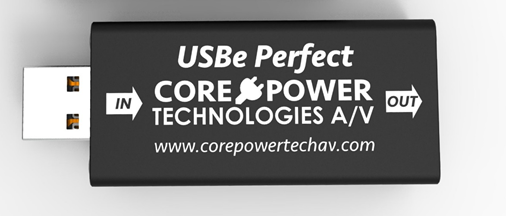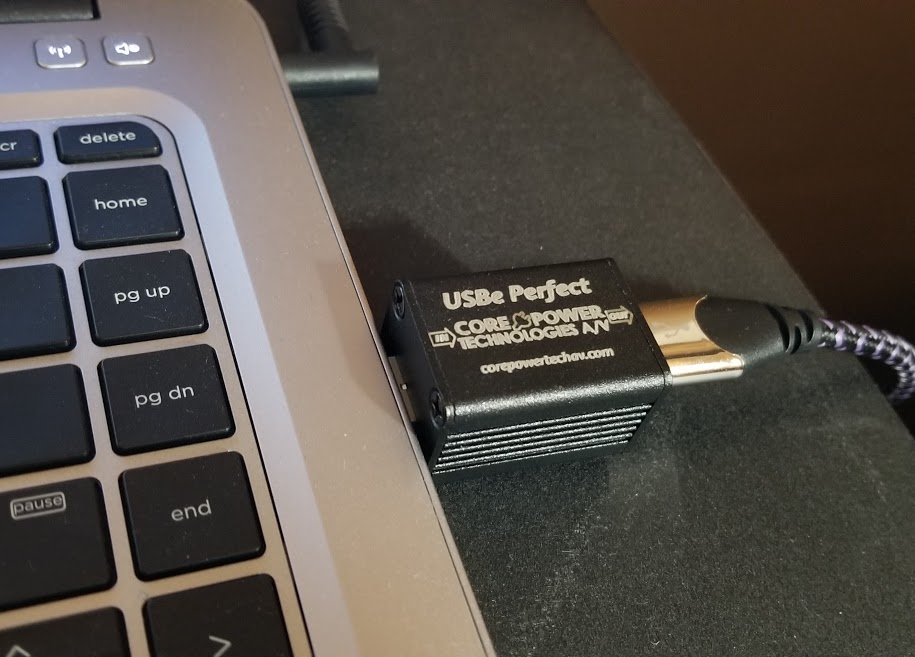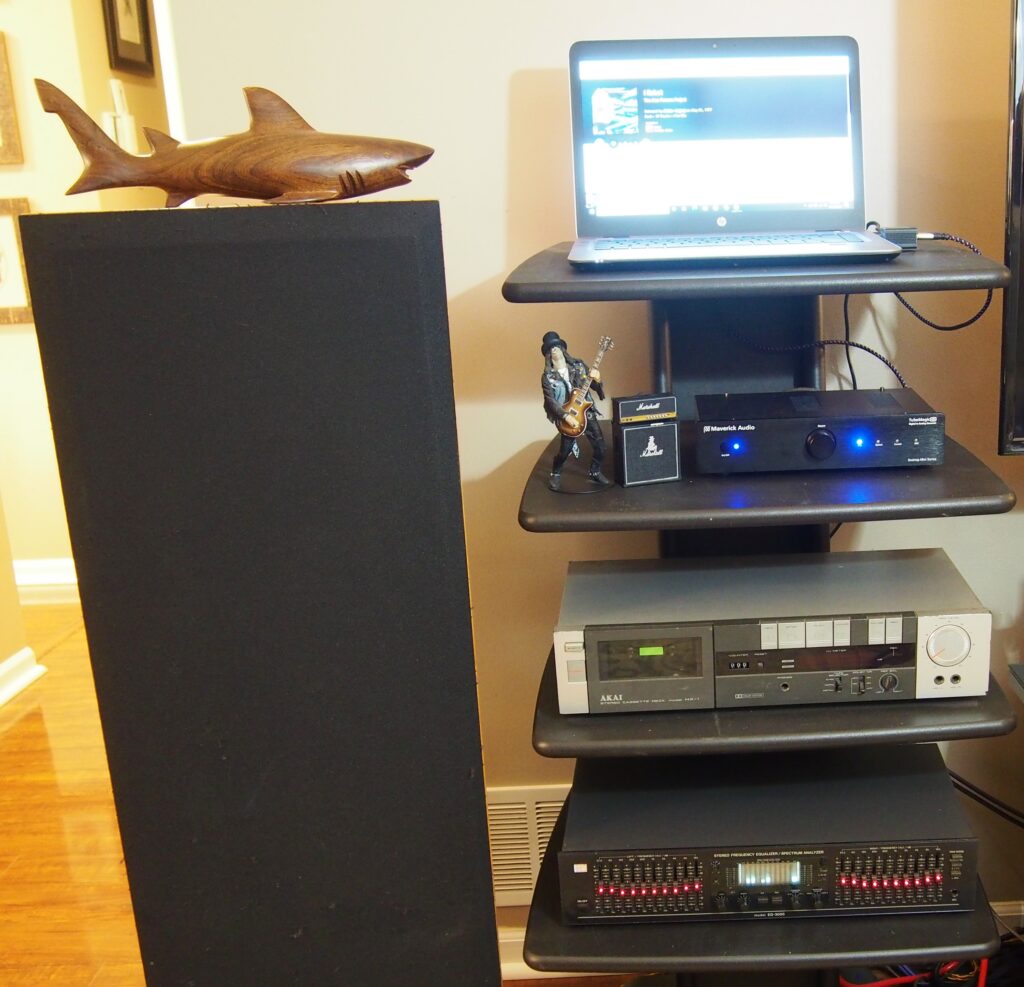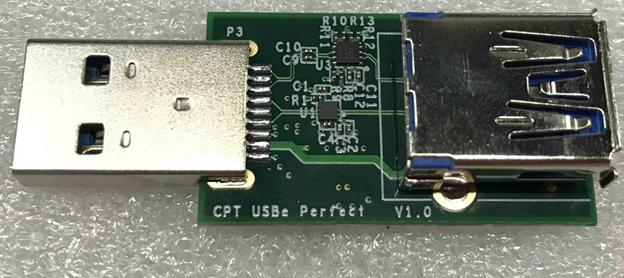I resisted. I held off. Unlike many of you who have wholeheartedly embraced the world of digital hi-res music streaming for so long, I kept it at arm’s length for longer than I should have. Now, I have several reasons/excuses for not taking the leap. First, I was watching the format wars, and listening to other peoples’ systems before deciding who I felt sounded the best. After deliberation and much consideration, Qobuz was a relatively easy choice. They won me over with pure fidelity and resolution.
Another “excuse” for me was that I had upgraded a couple of my turntables, acquired a ton of new vinyl, and found myself immersed in the world of wax for a while. I was happier lowering a needle than anything else.
However, as Qobuz has become the audiophile standard, my interest in the format has grown with it. The time finally came to get my streaming act together, Shoestring-style. Piece-by-piece, I began to assemble a new digital side to my living room multichannel system. Whatever I was doing, I wanted this to be somewhat mobile, so that I could use it with my two-channel reference system, as well as my vintage gear. This meant avoiding component-style streamers in favor of a laptop computer.
The new system
My new digital system starts with an HP 840 G3 i5 laptop, 16GB RAM, a Maverick Audio Tube Magic D2 tube DAC, and an Analysis Plus Purple Plus USB cable. A StraightWire Chorus cable handles the signal from the DAC to my Yamaha AVR. This makes for an instantly satisfying experience from Qobuz, while still keeping the system within a reasonable budget. However, there was no mistaking the fact that, while the music was hi-res, it was still coming from my new “square-headed girlfriend.”
There are two outputs from the Maverick Audio Tube Magic D2 DAC- a tube output and non-tube output. The tube output sends signal directly to the Yamaha AVR for the most direct line possible. The non-tube output routes to a vintage BSR EQ-3000 equalizer, then to an Onkyo A-8048V integrated amplifier for my outdoor speakers. This makes for a slightly more complicated, but ultimately cleaner, arrangement.
The USBe Perfect
When I received the USBe Perfect, I found somewhat little information on it – primarily that it vastly lowers the digital jitter from the music’s signal, so I wasn’t sure what to expect. The USBe Perfect is designed to minimize signal degradation effects such as crosstalk and intersymbol interference (ISI) that limits the interconnect distance between two devices. It has a full DC to DC regenerator built in. It generates a whole new DC signal, and then de-jitters it. The USBe Perfect is small, but built solid, in a metal housing, about one-inch square by an inch-and-a-half long and has a male USB at one end and female USB at the other. The device simply plugs into the source’s USB, and then your cable continues the journey to your DAC from there. It works with both USB 2.0 and 3.0 protocols, is compatible with both PC and Mac, and requires no installation to use. No power supply is required. Priced at $299, it is available from underwoodhifi.com.

Listening
Starting with a couple familiar reference tracks, I begin an A/B “with and without” trial of the USBe Perfect. First up is “Sailing to Philadelphia” by Mark Knopfler (24 bit/88.2 kHz). I run the first two minutes of the song without the USBe perfect in place just to get the song fresh in my ears. Now- pause, bring the track to the beginning, unplug the Analysis Plus cable, insert the USBe Perfect, replace the Analysis plus into the back of the USBe perfect, hit play and… nothing. Absolutely nothing. OK. A quick exit out of Qobuz, relaunch of the app again, hit play once more, and Eureka! Music!
Since the song starts out with a few heavy and distinct notes on the bass guitar, the difference with the USBe Perfect inline makes itself known quickly. Notes are rounder, smoother, and warmer. Once vocals come in at 19 seconds, they have a more natural timbre with a less boxy tone than heard without the USBe Perfect inline. Already, I’m intrigued.

Staying with the theme, “So Far Away” by Dire Straits (16 bit/44.1 kHz) takes me by surprise with the USBe Perfect inline. Without it, this track sounds CD quality through Qobuz, though good. With the USBe Perfect inline, the song takes on a more hi-res tonality. This setup is more musical, more organic, and carries a new depth. Since curiosity has me now, it’s hard not to bounce forward to “Ride Across the River,” which I’m more accustomed to hearing on SACD. While this does not quite match the SACD in terms of depth or detail, it is certainly giving it a run for the money, providing more than enough musicality.

Going in the opposite A/B trial direction, I begin “Shine on You Crazy Diamond (Parts 1-5)” by Pink Floyd (16 bit/44.1 kHz) with the USBe perfect inline. Here, I’m listening for all the subtleties, like the tone of each of David Gilmour’s guitar parts, and Nick Mason’s various percussion. There are chimes in the right channel at 4:21, for example. There are varying degrees of distortion in each guitar, or some with none at all. So much happens before the vocals even kick in. At about 8:00 in, I remove the USBe Perfect and listen again. Now it feels like something is missing. Something has been taken away. The track sounds notably thinner, and more digital. That digital sound comes over in the lack of passion in the guitars, and ring in those chimes at 4:21. After hearing the same eight minutes, I cannot wait to get the USBe Perfect back inline again.
The most mind-blowing Blu-Ray audio disc that I own is Bob Marley’s Legend. The mix is simply staggering, and it is one of my go-to “show-off” system discs. It is a tough disc to live up to. Leaving the USBe Perfect in place, it is time to demonstrate what Qobuz and the new device are capable of together. Legend is available in Qobuz in hi-res, so I immediately click on “Exodus” (24 bit/96 kHz), turn the volume up, and soak it in. Even with being so familiar to the Blu-Ray format, this does not disappoint in any way. Qobuz through the USBe Perfect produces a full, rich, and remarkably wide soundstage with this track. Choosing to forego the A/B trial here, I find it best to simply enjoy what my system is now capable of.
Sunday Morning Going Down
While doing more critical listening this gray Sunday morning and running a mellow Pat Metheny selection, New Chautaqua, I pick up on something my ears had been suspecting all along. There is just a slight hint of distortion. Unplugging the USBe Perfect and replaying “Long Ago Child” again, the distortion is still there. This is not the USBe Perfect introducing this, but the computer. Looking over the Qobuz dashboard, at the bottom, the default is that the gain is all the way up. Bringing the volume down to about 4/5 eliminates the distortion from the track. Replacing the USBe Perfect, New Chautaqua once again takes on more of the analog characteristic that I am accustomed to, having listened to this album since the ‘80’s.
Our life is not all hi-res, and we spend a lot of evenings outside in the backyard on our patio, around the fire pit or the stone table. On those evenings, my wife and I indulge in an iTunes playlist that I’ve built up comprised largely of 320kbpbs rips of the favorites from our CD collections. While not quite “audiophile,” it is everyday life, and provides great enjoyment. Shifting over to I-Tunes, the first thing I do is to bring the gain down, similarly to what I did with Qobuz.

The first track in my sights is John Hiatt’s “Memphis In the Meantime.” As soon as I double click, this is a treat. Never have the humble iTunes sounded this good! There is an instant enhancement to a much larger sound, and near CD quality that has been lacking. While certainly a thinner sound than Qobuz by comparison, iTunes now has a presence that makes it much more useable and listenable. Neil Young’s “Needle and the Damage Done” serves to further drive this point home. Feeling much more live and real, this song is more expansive through the USBe Perfect than it used to be through iTunes previously.
Wrapping It Up
Avoiding the “big things come in small packages” cliché is difficult when talking about something like the USBe Perfect. It is such a tiny device, yet does so much, sonically. It’s easy to be skeptical of a metal box smaller than a pack of gum when most components that make this much impact in our systems have a much larger footprint and cost much more. However, for those trying to achieve a less digital sound out of their streaming source, this is a very real solution. So, am I addicted to digital now? I just might be!
Associated Equipment
HP 840 G3 laptop
Maverick Audio TubeMagic D2 DAC
Yamaha RX-V663 receiver
Klipsch KLF-30 Loudspeakers
M&K K9 subwoofer
Analysis Plus Purple Plus USB cable
Straightwire Chorus II interconnects
KimberKable speaker cables
“Cuing up Cannonball Adderley’s tune “One For Daddy O”, at the very end of the tune you hear Miles Davis say, “Is that what you wanted Rudy?” With the JitterBug in line, it sounded fine, exactly like I’ve heard it at it’s best. But substituting the USBe Perfect suddenly made the sound of Rudy’s studio that music clearer. I felt more like I was at the session.”
Call me a well schooled audio skeptic , I spent over $4 k in digital cables ,
Have a uptone audio Ether net regen. On the input ,I thought nothing else needed ,
Wrong the Correct audio USBe perfect plugged into my server ,then my $1600
Final Touch Audio Sinope USB cable , the picture got a little more clearer still with a bit deeper soundstage ,in Audiophile terms $300 for a clearer more natural presentation
Is a true bargain and a very small price to pay ,even my stream8ng is clearly better
👍 great Job Walter at Underwood Wally.